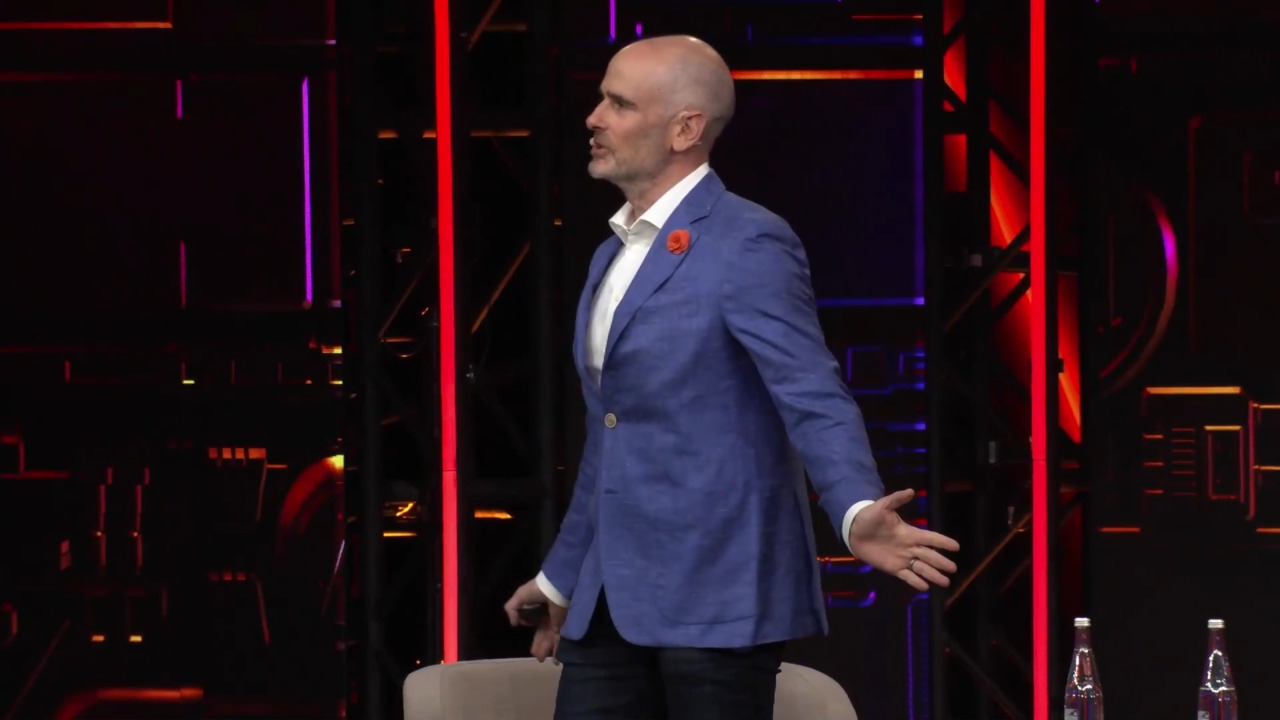00:05
I'm pleased to bring to the stage, Sean. Rosin Sean is our V P of R and D customer engineering. And he's going to talk a little bit more about the shift to all flash and what that means for customers in the future, Sean. Wow, I can't believe we're here on day two, but I'll tell you listening to AJ and listening to
00:32
Rob this morning. It's clear where the why is, it's clear why this move to flash and this density is so important because it brings simplicity, accessibility and efficiency to storage, to power. The next 10 years of innovation, what you saw today is only the beginning.
00:59
One thing is becoming increasingly clear like the transition from LPS to cds and vhs and dvds to streaming. Folks were in the midst of a tectonic shift in data storage. One that will be foundational for all enterprises and enable the next 10 years of innovation flashes the way forward.
01:25
But you know, I think we should just all pause for a second and pay homage to the hard drive after all hard drive storage is almost 70 years old. Let's thank it for over a half a century of loyal service at its origination. The industry's first hard drive held a mere 3.75 megabytes and weighed over a ton in cost. It was the equivalent in today's dollars of
02:00
$7500 a month. But let's just extrapolate that in today's dollars. That's the equivalent of playing $2 million per gig per month for storage hard drive. Innovation has been impressive. Over 67 years, we've seen tremendous innovations in both density and performance
02:22
from magnets to microwaves and even lasers. But like all great technologies, it's time for the spinning hard drive to pass the baton over to flash. This has already happened in the consumer space and now enterprises and hyper scalar are embracing the all flash data center to illustrate my point. Could you imagine carrying a smartphone around
02:46
with a spinning hard drive attached to it or having a spinning hard drive inside your electric vehicle? It will become as ridiculous to have spinning hard drives in the data center. Let me remind you again of what Charlie said at the start of our event, there will be no new hard drive sold after 2028.
03:06
This is not just a prediction folks at pure, we believe it's inevitable. We believe this because we know the following three things to be true. Number one, we are all facing massive compounding data growth last year. The estimates were that we would see a little bit greater than 25% compounded data growth year on year from 2022 onwards.
03:31
But these estimates were before the emergence and rapid adoption of large language models and generative ai co pilots, all of which are creating more data than any of us can. And the data is going to need to live somewhere and it will need to be easily accessible in order to deliver on its promise of productivity point number two, energy and power are finite and expensive.
03:54
Sustainability is our responsibility. I live in Vancouver Canada among some of the most beautiful mountains in the world and I want them to stay that way for generations. In addition to that, the price of electricity continues to rise, supplies constrained and some countries are even running out of capacity.
04:16
Even public clouds are reaching their power envelope because they're being turned away in countries from expansion due to power constraints. All of this is combined with our continued battle to slow climate change. While nuclear fusion claims to be the answer and has claimed to be the answer for decades, it's still many years if not decades away.
04:41
So coming back to Rob's Point in order to power the future, we're going to need to put energy efficiency at the forefront of our data architectural plans. Point number three, the cloud operating model will be universal from data centers to the public cloud to the edge. We will all consume it infrastructure as a service, whether on premise or in the public
05:05
cloud to enable maximum flexibility and agility. Remember, the public cloud was never about cost, it was about agility and the operating model is what will carry forward. Some of you started this journey with us over a decade ago. Thank you. Some of you have move to peer more recently. Thank you. Some of you are here to see what's possible
05:27
with pure today. Our portfolio and data platform is broader and stronger than ever allowing you all to deploy the power efficiency and scale of flash to all workloads. So what can you expect from us moving forward? Number one, we will continue to treat data storage as high technology, not a commodity and we will lead innovation with our purity operating environment and
05:55
direct flash modules. It will allow us to deliver maximum density and energy efficiency for all workloads with 75 terabyte DMS coming later this year, 150 terabytes. Next year, 300 terabytes in 2026 will be delivering 5 to 10 times the data density all within your existing power footprint. Remember folks since pure origination, we have driven driven density by 150 X.
06:24
And if my math is correct and if it isn't cause will let me know we're going to drive density. The next 5000 times we start talking about petabyte hard drives, petabyte DFM S the density is only getting started. The fact is S sds just don't measure up what else can you expect from us? Well, number two, we will help enterprises eliminate data silos and streamline their data
06:50
pipeline, accelerating their journey to A I. Rob laid it out beautifully. The amount of storage required to build your repository cache, your nodes, feed your GPS, take the results, optimize your queries. We've already seen it with hyper scalar like meta and ai innovators like media Zen who's doing, you know, language, speech to text translation.
07:13
We've partnered with them, we're allowing them to leverage flash and accelerate their parallel performance and feed their hungry GPS. While maximizing the power efficiency of their neural networks. You can also expect us to continue to ruthlessly drive simplicity, ruthlessly drive simplicity and automation across the portfolio with fusion and port works to be really clear. We're not just focused on the data center,
07:41
we're focused on extending simplicity from traditional to modern apps and from the data center to the cloud, all of this in the interest of freeing up human capital who manage storage directly and allowing them to accelerate your innovation. Lastly, you can expect us to lead in delivering all of our technology as a service, providing our customers maximum flexibility, seamless data mobility and non disruptive
08:08
upgrades. For all data. Over the last 24 months, you all delivered a ton of rapid innovation. This innovation spread across your enterprise. You were asked to enable hybrid work. You were asked to reach new markets. You were asked to deploy record numbers of net new applications all while executing global
08:30
operational excellence. That's not an easy task. But when you're deploying at hyper speed, like you were over the last couple of years, you don't have time to stop and evaluate your foundation, you just execute as you leave pure accelerate, I'd encourage you to take some time, take some time to celebrate and acknowledge all that you've accomplished. But also reflect on what you're going to need
08:55
from your data foundation to power your next 10 years. The decisions you make today are critical. If you delay your transition to flash, you'll be stuck missing out on incremental capacity and efficiency gains. Let me make this point really clear. The chassis you buy today will seamlessly move to 75 to 150
09:19
to 300. Put one of my competitors chassis, they're not going to give you that path. You see with pure, you get to ride the all flash wave and reap the benefits to close off over the last two days. You've heard about how Puris and direct flash technology is helping you our customers to
09:44
achieve unparalleled gains in performance reliability and 10 times the efficiency of traditional hard drives. Sean Hansen launched our new generation X and C models. We also saw our portfolio expansion with flash rate. E bringing the economics of flash to more and more workloads.
10:05
Folks, I couldn't be more excited. We're just getting started. And when we think about the future, we really look forward to continuing to expand our relationship with you and power your next 10 years of innovation. While I can't predict all that lies ahead, one thing is certain flash is the future and the future is now. Thank you.
10:35
Now, let's find out who our last breakthrough award winner is. Let's roll the video a healthier life. It's what everyone with a rare and inherited disease hopes for. It's what the health 2030 genome center is here for diagnoses often line in hundreds of terabytes of genomic data shaping treatment
11:00
plans, shaping lives. And that's why speed matters. The genome center relies on pure storage flash blade running on evergreen one to power DNA sequencing, whether it's 200 gigabytes or 200 terabytes pure can manage the load, driving unprecedented computing power that accelerates research and patient diagnostics and with pure one hours of daily operational tasks are a thing of the past.
11:25
Keeping storage capacity in line with actual needs, keeping patient data cure and keeping the genome center focused on the mission at hand. The result, researchers and clinicians can analyze data 10 times faster and patients can finally get the answers they need to live their best lives. A true data warrior. The genome center together with pure is
11:47
changing the face and the pace of genomic medicine, right. Congratulations to the health 2030 Genome Center for this year's data warrior win.

